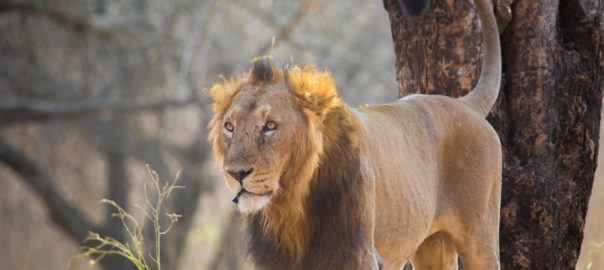The Asiatic Lion census for the year 2020 is to begin in May in the lion’s only wild abode in the world in Gujarat. However, rejecting new proposals of a tech-enabled census, the Gujarat government has decided to once again go the old-fashioned way of counting the lions.
In January this year, it was proposed that the Lion census in Gujarat will take place using 8,000-10,000 cameras. It was also said that the expertise of the Wildlife Institute of India (WII) would be used to count the lions. A month ahead of the exercise, the Gujarat government, however, has rejected both the ideas.
For decades now, the Asiatic Lions of India are counted using the direct-sighting method that involves thousands of forest officials, staff members, volunteers, and non-official experts counting the wild cats. A beat system is usually used where one forest beat guard is accompanied by two other members covering a distance of 10-15 sq km and looking for traces of the wild cat. This lion census is conducted every five years to know the population of Asiatic lions in India.
Also Read: The 9 Core Issues Affecting the Safety of Asiatic Lions in India
The 2015 lion census revealed 523 lions in Gir national park and the adjoining areas. But since then, most forest officers believe that their numbers have risen exponentially. An internal unofficial count touts the lion count to be anywhere between 900-1000 lions.
The range of the lions has expanded too. As against 15,000 sq km area surveyed in the last census, lions will be counted across 25,000 sq km area spanning seven districts in 2020.
The real picture
According to TOI, the Gujarat government has written to WII that they would not be accepting the proposal of special research during the census of 2020. The principal conservator of forest (wildlife) Shyamal Tikedar also adds that camera traps will not be used because unlike tigers, the lions are not elusive and the direct sighting method should suffice.
Some wildlife experts are not convinced. There is a possibility that the denial to use camera traps or take help from WII experts, is the state government’s way to keep the actual lion numbers under covers. With the growing number of Asiatic lions the state government is under extreme pressure to move a part of the population to another sanctuary in Madhya Pradesh which they are apprehensive about. It could also be a way to avoid the panic that may arise among people when they realise the number of lions roaming around human habitations is increasing. Some believe that the government only wants to portray a safe 30% rise in numbers.
Asiatic Lions once roamed throughout the Middle East, including Mesopotamia, Syria, Iran, Palestine, Arabia and Balochistan, along with much of Northern India to the Bay of Bengal till their numbers and territory shrank to the eastern parts of India. During those critical times when the big cat was facing extinction, the Nawab of Junagarh in Gujarat gave them royal protection thanks to which the numbers rose gradually from 20 in the beginning of the 20th century to more than 500 now. But with growing numbers and as the apex predators, lions need to establish territories, which is harder to find in the protected areas today.
Over the past few years, there have been frequent incidences of lions seen near villages and even near the coastal towns of Gujarat. While the locals are still extremely respectful of the royal cat and proud that its presence dominates their landscape, the same pride may not be allowing them to let go of the lions and create another healthy population elsewhere.
Also Read: 23 Lions Dead in Gir because of Canine Distemper Virus
If the lion numbers have indeed risen to more than a thousand, the chances of rising human-animal conflict increase as well. If India is willing to welcome African cheetahs and experiment with their survival on Indian soils, it should be far less easy and wiser to create another habitat away from Gujarat for the lions too. Manipulating numbers and creating a false sense of well being for the lions and the people may only lead to greater problems and a state of panic when the cats begin to claim territories outside the protected grounds.




